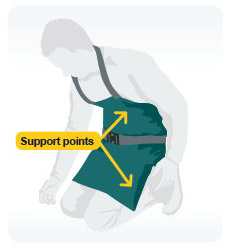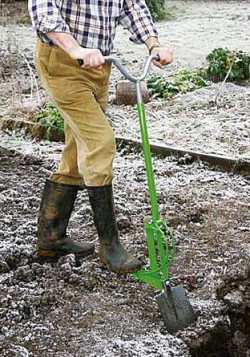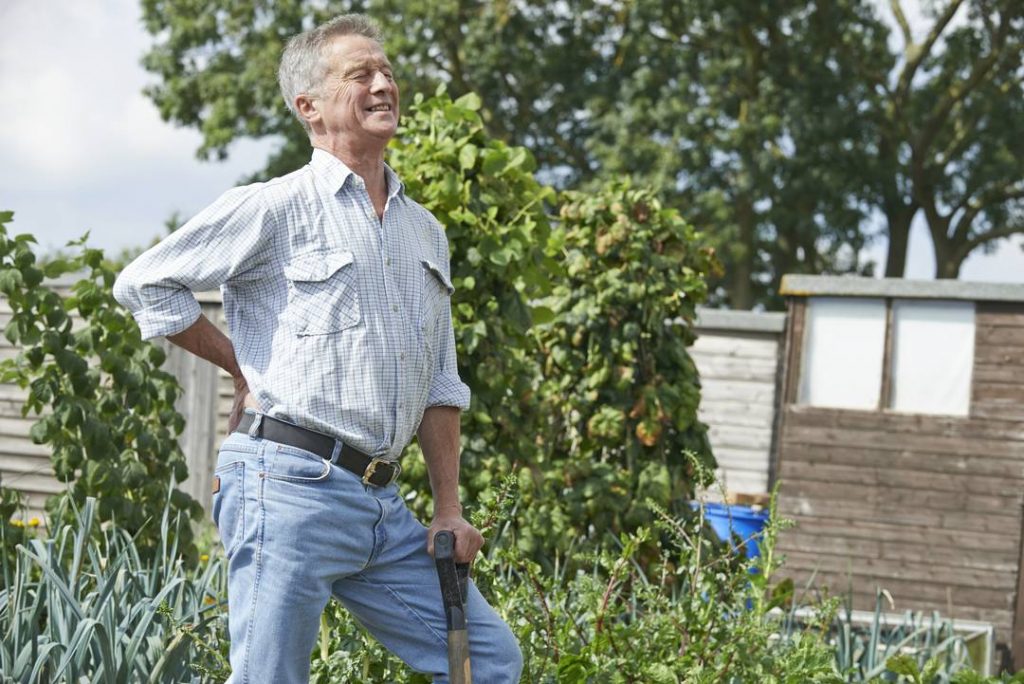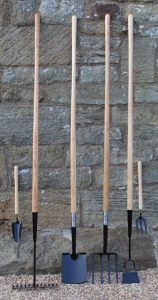Gardening is wonderful, as well as getting to eat the fruits of your labours, you actually get some good healthy exercise in the fresh air. But gardening and allotment-keeping also have their strains, and that includes your back pain.
A Gallup poll for the BBC – BBC News Site revealed that 42% of adults have suffered from back pain and nearly half of those said that the pain was as a result of gardening. What’s worse, as someone over 50, is that the proportion who blamed gardening for their back ache was even higher!
Having managed to develop sciatica myself, which I blame on lifting loads of leaves into the leafmould bin, I’ve a personal interest in back pain & problems.
So what should you do to reduce the strain on your back?
Be careful when lifting.

The Bak-eze apron to Relieve Back Pain
We all know the rule – bend your knees! Of course, it’s easier said than done but following this simple rule will prevent strain on your back. Once your knees are bent, grasp your load firmly. Then use your legs to push upward into a standing position. Avoid twisting whilst carrying a weight (that’s what did for my back).
Consider a Bak-eze gardening apron. It supports your back as you bend over, reducing pressure on the lower back. This is a remarkable invention by Peter Martinez, an engineer who suffered a broken back in a car crash at the age of 21. He found himself unable to do manual work or gardening because of the excruciating pain.
The Bak-eze apron works by transmitting much of the load and upper body weight to your thighs through built in patented springs, dramatically reducing the tension on your back muscles.
Sadly it doesn’t seem to be available now.
Warm up before you start

Backsaver Autospade for Back Sufferers
If you notice professional athletes always do warming up exercises before they race or whatever. It gets the blood flowing and the muscles moving. Before you start a heavy job, do some lighter jobs and ease into it.
Be careful when digging
Get as close as you can and avoid twisting. Don’t try to dig too much at a time, and take regular breaks. The Backsaver Autospade can help you dig at twice the speed of a conventional spade and means that you have to bend less.
It’s a new version of the Wolf Terrex Autospade. This ingenious tool (popular in the 1970s and now back in production) was specially designed to reduce back strain and effort with the bonus of digging at up to twice the speed of a conventional spade.
All you have to do is take a spit, pull back on the comfy handles and a large spring at the base of the shaft acts to throw the soil forward and turn it over.
It features a carbon steel blade which holds a lovely sharp edge, galvanised fixings and ‘comfy grip’ PVC handles.
Long Handled Tools
One cause of back problems when gardening is using tools that are too short. The obvious solution is to use tools with long handles.
Long Handled Garden Tools allow you to work from a standing position to eliminate bending and avoid back pain.
They are novel designs but with a traditional look and traditional quality. Very carefully shaped heads and extra long handles for optimum leverage and balance, forged in carbon steel to make them super tough and long lasting, with hand finished ash handles.
Bespoke manufacture was by R.Carter Ltd. of Huddersfield who have 275 years experience of toolmaking but sadly no longer making these.
Carry smaller loads and pace yourself.
Remember, take your time, don’t try to do everything at once. Gardening is supposed to be fun!
Disclaimer
I’m a gardener, not a doctor so we make no representation or warranty of any kind in relation to this advice.
Growing Guides, Information & Articles
- 3 Creative Ways To Beautify Your Garden
- 6 Ways to Enjoy Your Garden More This Summer
- Cats Toileting: How to Stop Cats using Garden or Veg Plot as a Toilet
- Desert Botanical Garden – what makes it so special?
- Full Spectrum Light – Grow Lighting using LED
- Garden Hints & Tips
- Garden Pests – Rabbits, Deer, Pigeons, Badgers
- How Fast Does Cherry Laurel Grow?
- How Inflatable Hot Tubs Improve Your Garden Ten Fold
- How to Care for a Peace Lily Indoors: Step-by-Step Guide
- How to Get the Most Out of Your Garden
- How To Give Your Garden A Makeover During Lockdown
- How to Grow Gladiolus in Your Garden
- How To Make A Side Income From Your Garden
- How to Protect Your Vegetable Garden from the Wind
- How to take care of your pond
- Microgreens – How to Grow Micro-greens Winter & Summer
- Modern Garden Ideas Featuring an Outdoor Firepit
- Planning a garden or allotment clearance
- Redesigning flower beds – How to do it
- Repair Rather Than Replace Old Garden Machinery and Power Tools
- Starting Them Young: 6 Homesteading Skills to Teach Children
- The Role of Campus Gardens in Student Mental Health and Well-being
- Top tips for amateur gardeners: get started today
- Why are LED Horticultural Grow Lights Purple?
- Zen Garden for Meditative Space
- Best Temperatures for Seed Germination
- Raised Beds – Vegetable Growing in Raised Beds
- Seed Saving
- Lawn Care Guides and Advice
- 10 Ways to Increase the Aesthetic Appeal of Your Backyard
- Fluid Seed Sowing & Seed Pre-Germination
- Home Made Pesticides & Unlicensed Use of Pesticides
- Decorative Garden Arches – Roman, Gothic, Ogee Garden Arches
- 5 Popular Uses for Log Cabins
- Grow Your Own Vegetables, Fruit, Herbs & Nuts
- Weed Control
- Gardening And The Importance Of Water Quality
- How to Build a Concrete Garden Path
- Concrete Garden Path Construction – Step by Step Photo Guide
- How Can Gardeners Cope with Climate Change?
- Gardening & Growing Vegetables Under a Hosepipe Ban
- Water Conservation: Garden Techniques
- Flood! Safe Growing & Harvesting of Crops After a Flood
- Day Length and Growing Plants
- Gardener’s Back Pain – Look After Your Back in the Garden
- Become an Urban Farmer and Start Growing Potted Plants
- Allotment Vegetable Plot Planning Software
- Start Your Seeds Indoors For A Jump On Spring Planting
- An Eco-Friendly Garden Backyard – Green Gardening
- Lunar Gardening, planting and gardening according to the phase of the Moon





